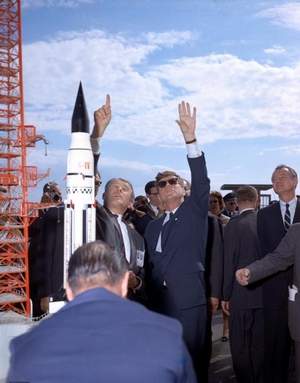On November 16, 1963, President John F. Kennedy traveled from Palm Beach to Cape Canaveral, Florida on a Saturday morning, where he visited Pad B at Complex 37 and was briefed by Wernher Von Braun on the Saturn rocket booster.
JKF is seen in the photo below with (L-R) NASA Associated Administrator Robert C. Seamans, Jr., Florida Senator George Smathers, NASA Administrator James E. Webb, Dr. Wernher Von Braun (partially hidden), NASA Deputy Administrator Hugh L. Dryden, and military aide to the President Chester V. Clinton. Although not shown in the photo, long-time aide Kenny O’Donnell also accompanied him on trip.
[image src=”http://airwingmedia.com/wp-content/uploads/2013/11/JFK-Cape-Canaveral-1.jpg” responsive=”true” lightbox=”true”]
Inside the Launch Complex 37 blockhouse, scale models arranged on a table previewed what the massive Vehicle Assembly Building, launch pad 39A and Saturn V rockets would look like.
Pointing to the models and charts propped on easels, NASA leaders briefed the president on progress developing the facilities and rockets that would support Moon shots by his end-of-the-decade goal.
[raw][slideshow controlnav=”false” directionnav=”true”]
http://airwingmedia.com/wp-content/uploads/2013/11/JFK-Cape-Canaveral-2.jpg
http://airwingmedia.com/wp-content/uploads/2013/11/JFK-Cape-Canaveral-3.jpg
http://airwingmedia.com/wp-content/uploads/2013/11/JFK-Cape-Canaveral-4.jpg
http://airwingmedia.com/wp-content/uploads/2013/11/JFK-Cape-Canaveral-5.jpg
http://airwingmedia.com/wp-content/uploads/2013/11/JFK-Cape-Canaveral-6.jpg
[/slideshow][/raw]
[hr4]
 A famous image shows Kennedy standing with legendary rocket scientist Wernher von Braun near a model of the rocket and pointing up to the real thing.
A famous image shows Kennedy standing with legendary rocket scientist Wernher von Braun near a model of the rocket and pointing up to the real thing.
“He saw the enormous magnitude of this undertaking, which he probably didn’t understand previously,” said historian Roger Launius of the Smithsonian Institution’s National Air and Space Museum. “But when he sees a model of the VAB and then talking about how big it’s going to be, when he sees models of the Saturn V and the real-life Saturn I — when he sees all that stuff, he really sees how big and significant and expensive this thing is.”
Kennedy considered it extremely important — and instructed NASA officials to emphasize to the press — that the million-pound thrust booster would for the first time exceed the Soviets’ lifting capability.
[image src=”http://airwingmedia.com/wp-content/uploads/2013/11/JFK-Cape-Canaveral-7.jpg” responsive=”true” lightbox=”true”]
[hr4]
During his time in Cape Canaveral, JFK also viewed a Polaris missile being fired from the nuclear submarine Andrew Jackson.
The next week the President died by an assassin’s bullet in Dallas, The new President, Lyndon B. Johnson, announced he was renaming the Cape Canaveral Auxiliary Air Force Base and NASA Launch Operations Center as the John F. Kennedy Space Center. With the support of Governor Farris Bryant of Florida, the President also changed the name of Cape Canaveral to Cape Kennedy. The next day he followed up his statement with Executive Order No. 11129. In this he did not mention a new name for the Cape, but did join the civilian and military installations under one name, thus causing some confusion. To clarify the matter, Administrator Webb issued a NASA directive changing the name of the Launch Operations Center to the “John F. Kennedy Space Center, NASA,” and an Air Force general order changed the name of the air base to the “Cape Kennedy Air Force Station.” The United States Board of Geographic Names of the Department of the Interior officially accepted the name Cape Kennedy for Cape Canaveral the following year.
[hr4]


